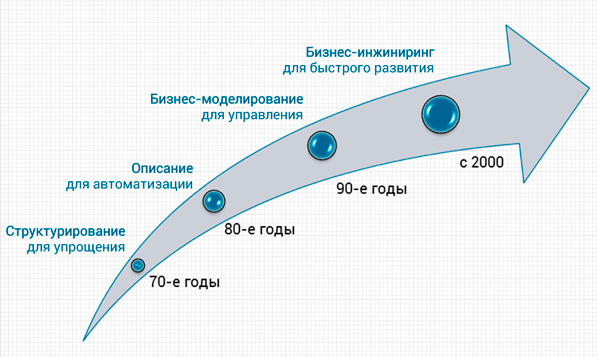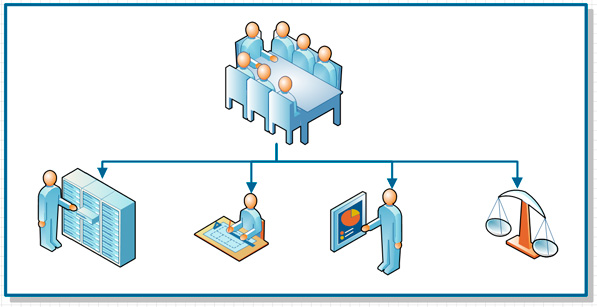Business processes - a new era in management?
Any activity is always a kind of process, since it has an extension in time, stages and a result. Therefore, from handicraft or handicraft production to modern high-tech companies, everyone is engaged in processes. What has changed recently? Why has the topic of business processes become so relevant today? In this material, I will try to disassemble the process approach to managing an organization and reflect the specific features of a new view of management that brought with them the theory of modeling and reengineering.
History of the issue
Researchers in the field of management are constantly concerned with the issue of the universality of theories and the provability of solutions. It is desirable, as in mathematics, to find axioms and constants on which one could confidently rely in the search and decision-making. The second important topic is the language for displaying decisions related to organizational and management systems. The most successful attempts to make management science more coherent are accounting and financial statistics. These are very valuable parts of management, but, unfortunately, not suitable for "mere mortals" who need to not only make the right decision, but also convey it to all personnel. Here we can also talk about network planning and graph theory, but still this approach remains controversial for many.
In the 70s of the last century, in complex military projects, American specialists came to the need to visually structure their activities, and since then such a concept as a business process has been firmly entrenched in management practice. This period can be conditionally called "structuring" of the business, since the purpose of building visual diagrams of activities at that time was in identifying logic, dividing areas of responsibility, defining the flow of documents and products, and this action itself greatly accelerated and simplified understanding, revealed inaccurate places and breaks.
At this stage, the business process was defined as a set of sequentially or / and parallel operations performed, transforming material and / or information flows into corresponding flows with other properties. Of course, here we are not talking about the fact that the process was first seen in the activity (the processes were already improved by Adam Smith in the 18th century, and Henry Ford perfectly built the production processes), but about the fact that a tool for displaying and systematic analysis of the company's activities through process diagrams appeared ...
Visual reflection of the business processes of the enterprise significantly accelerated and simplified the automation activities, therefore, in the period of the 80s, the emphasis shifted to the description of automated business processes. It was a period of active involvement of computers in all areas of production and management. Naturally, description alone was not enough for managers very soon, so a new level of complexity began to form - process management.
The process approach considers management as the work of a special person ("process owner") to design an effective sequence of actions to create a formulated result in given conditions and ensure the implementation of these actions (process). That is, the focus from managing people in process management is shifting to managing flows of actions and results.

Modeling development stages
Having embarked on the path of streamlining business processes, management sooner or later must switch to process management throughout the company, since the flow of activity, like the flow of water, cannot exist in a confined space - where movement is limited. That is, the company is forced to comprehend all its activities as a network of interrelated processes, to link them in such a way that they strengthen, rather than weaken, each other. This requires modeling of all activities in a complex. This stage began in the West around the 90s. Everything happens with some lag in our country, but it strongly depends on the industry. Rapidly developing industries (such as telecommunications) have long and successfully mastered these technologies.
A feature of process-oriented management is the definition of business processes as an interconnected set of works that ensure the achievement of the goals set by the company (implementation of the strategy), which is an order of magnitude more difficult than managing a local process. Here, the focus of management is shifted from production and logistics processes to "office" ones.
The assessment showed that design, planning, accounting, and other processes are often the main culprits for low speed and high cost of production processes. That is, they ultimately determine the properties of the processes that create value for the customer.
Thus, in order to achieve success, the management of the company itself must be subjected to modeling and optimization, but sometimes this is extremely difficult, since most often it is observed:
- high uncertainty in the actions of managers;
- lack of the necessary competencies in process management;
- psychological unwillingness of specialists and managers to “drive themselves into the framework”.
Therefore, the next stage in the development of modeling tasks is inevitable - this is the initial competent design of all company processes as a single effective system - business engineering. Business engineering methodology views management as a service link to the value stream, as it should be. At the same time, the implementation of the process approach occurs almost automatically and does not require efforts to overcome the resistance of any of the groups of personnel (of course, if everything was correctly designed from the beginning).
I plan to consider the topic of business engineering in more detail in the following articles. Here I would like to pay attention to the options and subtleties of the business process as a modern management phenomenon.
Management phenomenon
Having considered the dynamics of the development of the process approach to enterprise management, I think that no one doubted that this is serious and for a long time. My personal opinion is that the transition to process management is comparable to the transition from calculations on fingers to calculations using records, formulas, rules. As the object of management becomes more complex, management technologies must inevitably become more complex.
But is it really that difficult? Where does the modern executive face the barrier to the benefits of the process approach? My observations show that the leader, by virtue of tradition, imagines the organization in the form of an organizational structure, where the main thing is information about the division of employees into divisions and about responsibility for each group. Let's compare what the structure and business process diagrams look like, drawn using the same visual means.

Structure

Obviously, the main difference between the schemes is the presence of a flow in the second scheme, which unites all participants with a certain logic. Managerial work differs in a similar way. In traditional functional management, this is a "division" of attention, work, reward, which is a very laborious task and does not guarantee anything.
In the transition to a process-oriented approach to management, company management can no longer be viewed as the work of a "overseer", but rather as the work of a coach, conductor, director, etc. - that is, the task changes from division and control to the formation of the best configuration of conditions to maximize the stream of value created.
It can be concluded that the whole difficulty lies in the habit of using the traditional version of management, and partly in the fact that there are no visual ready-made process models, and their creation from scratch requires serious efforts of the management team.
Principal elements of process management
- Identification of key performance results and their comparison of the company's business processes.
- Determination of clients of business processes and their requirements (in the future, it is necessary to establish a strong connection with them and continuously monitor their satisfaction, since it is the client with this approach that becomes the main measure of the quality of the process).
- Creation of the structure of business processes, based on the importance, nesting, chronology of activities.
- Determination of the parameters of business processes.
- Determination of responsible persons and executors of each process.
- Designing logic is a technology that should ensure the creation of the desired result in the right time frame.
- Setting up a synchronization system for the activities of different processes (ideally, automation of planning and control of all process indicators).
- Personnel training - the formation of readiness for group responsibility for the result (often this requires a sufficiently strong restructuring of the motivation system).
- Formation of a cyclical mode of design-analysis-adjustment of processes, based on the results of the analysis - the so-called "business rhythm".
An important stage in the development and description of activities is the definition of the characteristics of business processes. Almost every methodology identifies the following elements.
- Process boundaries, which are defined by start events and inputs (resources), as well as end events and outputs (results).
- Process regulations. This includes both external legislation and company-issued rules, plans and instructions. Unfortunately, in companies it is rare to find well-written control documents, so the main delay in the transition to process management arises from the need to develop the required number of rules and instructions.
- Process resources: performers and participants, equipment and tools, information systems and other important elements, without which the process is impossible or ineffective.
- Process indicators are measurable process variables and their guideline values. These may include not only the volume of the result, but also the time spent on the process, the amount of material or money lost, the number of rejects, the customer satisfaction index, etc.
All this can be described in simple text or tabular form, but it is not in vain that designers use graphical methods. Any construction, including organizational, will be much more deeply detailed and meaningful if it is presented visually and in the context of the rest of the system.
Visualization of processes in the form of technologies can be simple, as shown in the figure above, consisting of infographics available to any employee, or it can be more complex, performed using special process modeling tools. In this series, I plan to describe all the most interesting and available modeling notations. For now, you can familiarize yourself with two of them - and.
In any case, the methodology provides direction and tools, while the value for the company is created by the management team, which forms the management system. Even the most accurate method does not guarantee that the mechanism will work like a clock, if there is no master who understands this “clock”, adjusts and maintains it.
I think no one has a question whether business processes are needed or not and why, because when there is a business, by definition there are business processes. Therefore, one cannot say that working with business processes is a fundamentally new era. But nevertheless, the shift in emphasis, new tools and technologies are significantly changing the essence of management work. Those who understand this have a chance to create a much more manageable, mobile and efficient business than those who are guided by the old-fashioned management - often through psychological pressure on subordinates.
 Discounted payback period
Discounted payback period Methodological aspects of project management
Methodological aspects of project management Scrum development methodology
Scrum development methodology